For a lot of knitters, seaming finished pieces together is their least favorite part of of a project—it’s time-consuming and can turn out so ugly. But for those who have joined the cult of mattress stitch, the technique of sewing pieces together on the right side for a virtually invisible seam, finishing is a relatively effortless and almost magical process. Mattress stitch is also a very handy skill for making great looking knitted toys.
There are several good mattress stitch tutorials on the web, but since there are some specific issues with seaming toys that aren’t found so much in garment knitting, I thought it might be helpful to do a toy-specific tutorial on the techniques. In this post, I’ll cover the basic “flat” seaming: vertical, horizontal, and vertical-to-horizontal mattress stitch. Then I’ll demonstrate how to use mattress stitch to sew on a 3-dimensional limb, such as an arm, and also how to sew on a limb at an angle. (I’m not going to do any techniques for garter stitch, since I rarely use it in my toys.)
Vertical Mattress Stitch
Vertical mattress stitch is used to join the edges of two pieces together when the knitting is running the same direction on both pieces . Among Mochimochi Land patterns, Grass, Evolving Punk, andLuvgun call for this basic stitch.
Start by placing your two pieces side by side with the right sides up. For toys, you will actually often start by holding the pieces together with wrong sides facing each other, but the technique is exactly the same, and easier to demonstrate when laid flat.
Insert your tapestry needle under the horizontal bar between the first two stitches on the edge you want to join.
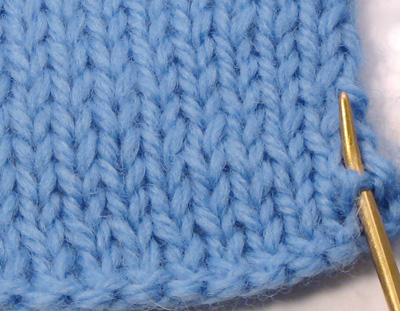
Pull the yarn through and slip the needle through the opposite horizontal bar on the other piece.
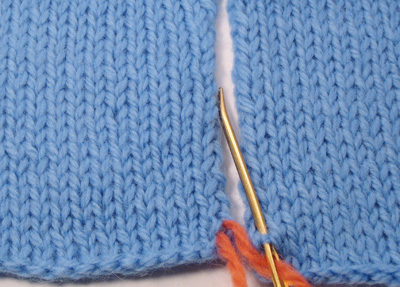
Continue to go back and forth under the horizontal bars along the seam.
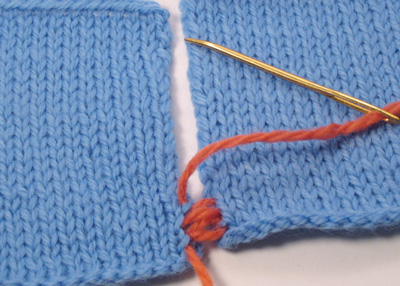
Now for the magic: pull on the yarn to tighten up your stitches…
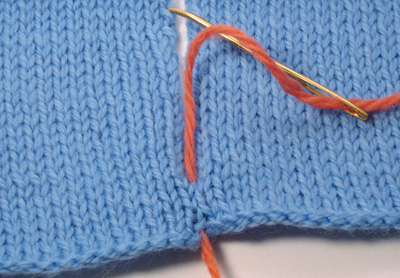
And they disappear entirely! No matter now how many times I see that, I still ooh and ahh at the trick.
So that’s the basic mattress stitch, and it’s beautiful. But what if you need to seam around all of the edges of the pieces, as with many toys? When you get to the top of the knitting, you can simply turn the corner and seam the top of the knitting together with horizontal mattress stitch.
Horizontal Mattress Stitch
This stitch is used when you are seaming together the cast-on or bound-off edges of two pieces of knitting. If you’ve just finished vertically seaming up one side of the knitting, just turn the corner and continue with horizontal mattress stitch. (It will look pretty strange at first, but when you tighten up your yarn, the seam will disappear.) Horizontal mattress stitch is also used when sewing up the holes between the feet or ears of animals, as in the Mochimochi Reindeer.
For clarity, I’m again demonstrating this technique with the knitted pieces side by side, though with a toy you would normally be holding the pieces together with the wrong sides facing each other.
Insert your needle under the point of the V of the first stitch. Pull the yarn through, and do the same with the opposite stitch.
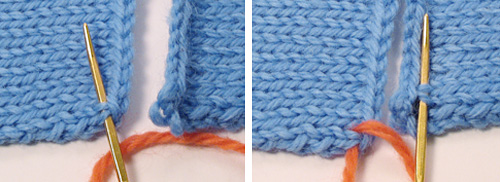
Continue back and forth across the edges, tightening up your yarn a bit after the first few stitches.
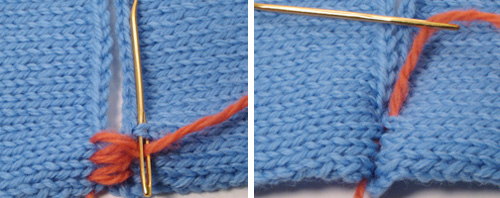
Here’s a photo of our square seamed together all around the sides, using vertical and horizontal mattress stitch. Since you’re sewing on the outside of the knitting, you can stuff as you go before closing off. (On a side note, if you’re using safety eyes, remember to attach them before closing off.)
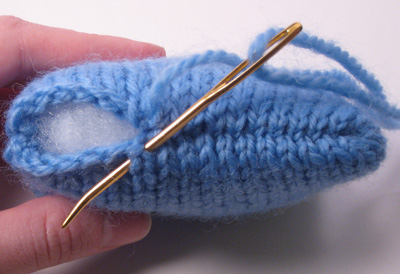
Vertical-to-Horizontal Mattress Stitch
Sometimes, you need to seam together two pieces with the knitting running perpendicularly. This occurs in the pattern for Tubby, for example.
The technique, as you might expect, is basically a combination of vertical and horizontal mattress stitch. Insert your needle under the horizontal bar of one piece, then under the opposite V of the stitch in the other piece.
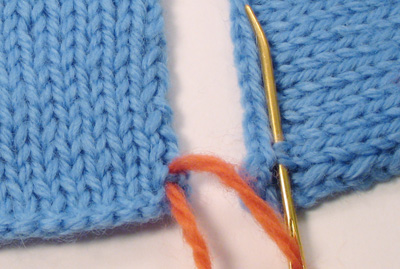
However, since rows of knitting are slightly more compact than horizontal stitches, they usually won’t match up with a perfect 1:1 ratio, and you will need to make some adjustments as you go along the seam. This is best done by occasionally inserting your needle under two horizontal bars at once.
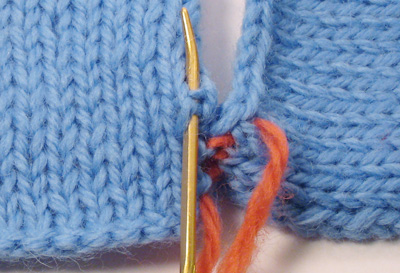
There isn’t an exact formula for how often you will need to insert your needle under two bars instead of one to make the two pieces match up; you will need to eye it for yourself as you go along. This can seem a bit tricky, but the good news is that the seam will again be virtually invisible once you’re finished, and you shouldn’t be able to tell where you made the adjustments.
Sewing on a Limb (perpendicularly)
Above, we have seen how mattress stitch can make beautiful seams when joining flat pieces together. It’s even more of a lifesaver when attaching limbs (arms legs, ears, etc.) to a toy. Again, it’s almost invisible, and it also makes it easy to sew on limbs at any angle.
Let’s attach an arm to our square, which we’ll now call the toy body. First, decide where on the body you want to place the arm.
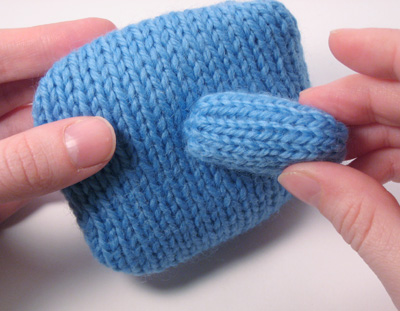
You’ll see that some of the stitches on the arm line up with the horizontal stitches on the square. That’s where I like to start seaming, using horizontal mattress stitch.
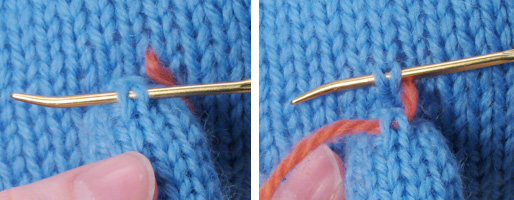
Soon, the stitches stop lining up, and you have to turn a corner, so to speak. Insert your needle under one side of a stitch on the body, and up through the middle of the stitch immediately below it (or immediately above it, as the case may be.)
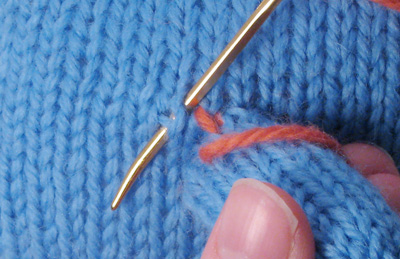
The next few stitches will line up vertical-to-horizontal, so continue with vertical-to-horizontal mattress stitch.
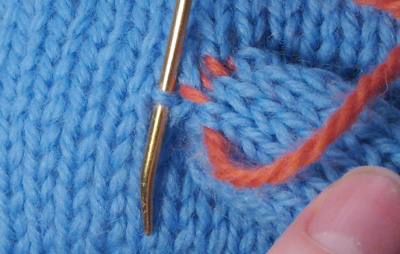
You’ll then turn the corner again, and switch back to horizontal mattress stitch. Continue to seam around the circumference of the arm until you arrive at where you started. You will end up with an arm that is sticking straight out.
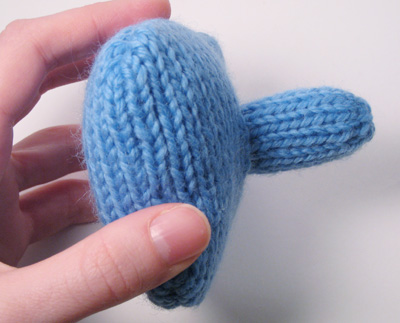
Sewing on a Limb (at an angle)
Not all knitted toys want to hold their arms straight out. Some want to have them down at their sides, or reaching upward, or out in front of them.
Since we’ve attached one of our toy’s arms out straight, let’s angle the other arm down at its side. First, sew along the side of the arm opposite from the side to be folded down or up—in our case, the top of the arm, since the bottom will be folded down. Use horizontal mattress stitch along the top of the arm, then turn the corner with a diagonal stitch, just as you would with a straight-out arm.
Now we’re on the front side of the arm. For the next stitch on the body, insert your needle under two stitches. Then, instead of inserting your needle under the bottommost stitch on the arm, insert it under the next stitch up.
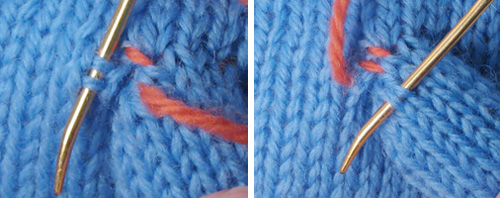
Repeat this along the side of the arm, until you get to the part of the arm that should be flat against the body. (Since our arm is relatively small, we’ll repeat only once more.)
Now you’ve reached the bottom of the arm, or the armpit. Use horizontal mattress stitch to continue along the bottom, but for the stitches on the arm, now insert the needle under the third or fourth V-stitch from the base of the arm.
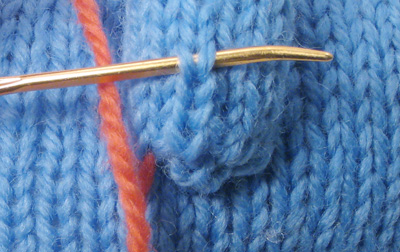
This will pull the arm downward.
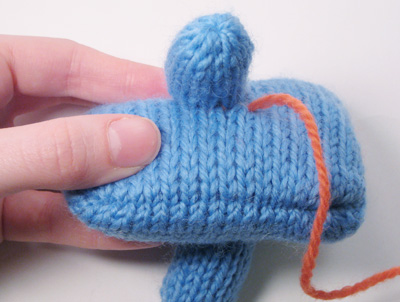
Once you’ve finished with the armpit, continue up the back side of the arm, in the same way that you did with the front side: insert your needle through two stitches on the body, and through the second-from-bottom stitch on the arm.
When you come back around to the top of the arm, you will end up with a nicely downward-pointed limb. And a new friend!
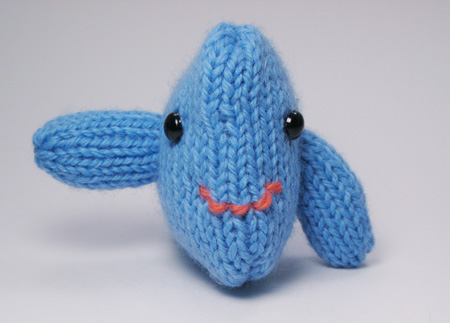
I hope this tutorial comes in handy to some people. I would greatly appreciate any feedback, and I’m happy to answer any questions in the comments.

What a great tutorial!! Very informative and handy!! Thanks so much
Your photos and instructions are very clear! This will make joining so much easier. I thank you for sharing this!
What a great tutorial. Thank you for sharing, this is very timely for me as I finish off a little toy project. I have bookmarked for future reference!!
Well done, excellent, I commend you!
Very, very handy tutorial. Thank you. I do have one question about attaching the perpendicular arm. I just sewed a stuffed head onto a stuffed body in a similar way (before I read the tutorial, when I was just feeling my way along), but it was too floppy. Does floppiness happen when there are too few stitches? Or, did I choose the wrong row on the head to attach to the body? Perhaps one further up his “skull” would have been better?
The question, what do you do to prevent floppy limbs?
Great tut! I especially like the trick to sewing on an angled limb. Now if only I could find a tut for seaming reverse stockinette I’d be all set! (Not for a toy, but it’s slowing a project up big time!)
Love your blog, and I adored seeing you and your toys on Martha’s show a bit ago!
I’m really happy to hear that my instructions are follow-able—thanks everyone for letting me know what you think! As I was writing this post, I was getting a little concerned that the whole thing would be waaay too long. At the same time, I didn’t want to leave anything key out.
Maureen, I would suggest that you try sewing up a row higher on the head of your toy, as you mentioned, and perhaps also a row outward on the neck/body. I’ve adjusted things this way without even taking my first set of mattress stitch out, just adding an additional row. That way, if you’re not happy with the way it looks with your new stitches, you can simply take those out and you’ll still have the first ones you did.
More stitches might also help, but I’ve found that the placement is the most important thing. Let me know how it goes!
Great tutorial! I always have problems doing this… I hope this helps me…
So helpful! I wish I’d known this before I finished the robot toy I made for one of my college buddies. But I’ve decided to consider it a prototype anyway, so…
Superduper tutorial, Anna. Thanks!!!
Great tutorial and nice, clear pictures! I haven’t had to seam too many things yet, but when I do, I know I will be headed back here for a lesson! :)
Oh, THANK YOU!!! Anna, you rock! This tutorial is just what I needed. I’ve understood the flat to flat mattress stitch, but I couldn’t quite conceptialize limb to body type.
Thanks Anna! No matter how hard I’ve stared at pictures in books, I can never seem to get the hang of mattress stitch. The length of your tutorial is perfect…not too short, like most explanations of mattress stitch…not too long, for obvious reasons. I think most people are scared of seaming, that’s why they don’t explain it fully. This will really change how I seam knitted toys. Thanks again!
kekeke…now..i hope the next toy i finish will have proper seam and proper limbs!!=P
Thank you ANNA! u are great!!!
I think it’s time you wrote a book, Anna. Pictures of your toys, plus clear, illustrated instructions of the more difficult techniques, would be a real boon to the knitting world. Very well done!
this is a great tutorial, Anna! thank you so much for putting it up!
Wow! Thanks so much for the tutorial. I have just started making toys and I love it, but my seaming skills are lacking. I can make them look okay, but this should help the seams to look more professional. I can’t wait to get practicing.
Thanks, Anna. I appreciate the tutorial & will try your tactics on my next knitted toy.
I think your tutorial is fantastic. Thank you so much!!
Thanks!! I just finished sewing up one of your toys and I did this ugly whip stitch thing to put the parts on. Because I didn’t know how to translate the mattress stitch to 3D objects.
Next time, I’ll have a better looking toy!
Such a clear and helpful tutorial. Sewing is my least favourite part of making toys but only because I never knew what I was doing… before now. Thank you!
As my grandma says, whenever anyone does anything nice for her:
“You are my new best friend!”
Thank you…this will be very, very helpful…
I have a couple of knit toys that are all done except the seaming. I was feeling stymied by the whole process. I thought I was going to have to whip stitch the limbs on, which does the job but cuts back on their aesthetic appeal. Thanks to your tutorial, I know just how to proceed! Thank you, thank you, thank you!
I cannot tell you how much this is so very very helpful! Mattress stitch is always hard to do (I sometimes can’t do it evenly) and I always love photo tutorials as I am a very visual person.
The most awesome tutorial ever! Thank you so much!
What a great tutorial. Thank you so much.
I will try it when I sew my teddy bear together.. I have it bookmarked so I can go back if I have trouble..
Awesome tute, especially the one about sewing on a limb.
This is awsome and I will definately be refering to it often. Thanks
wow!! This is awsome thank you so much!! Its like magic >w<
Great tutorial! When I first started knitting, I made all these gnomes and pixies (waldorf-influenced) and I just attached them willy-nilly and they all have these arms-raised-praise-the-lord stance. It kind of cracks me up now.
I have my gnome pieces knit and was having difficulty getting the seaming started. With some highpowered glasses I should be able to progress through the tiny stitches just fine and this tutorial has helped. Thanks:)
Your tutorial saved my life. I am making my first attempt at a knitted figure that is NOT felted. My seams look amazing and I, as you, am amazed at pulling the yarn and seeing the seams zip together.
Thank you, thank you!!!!
Thanks for the fantastic tutorial. It is the best that I have ever found for seaming limbs!